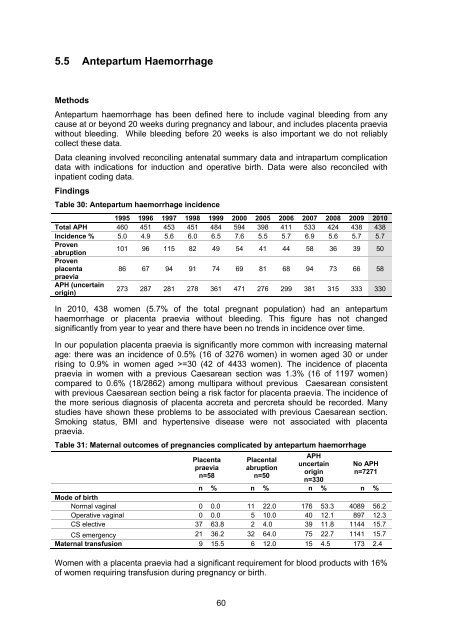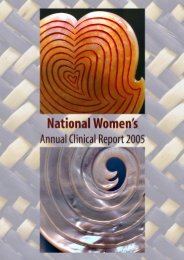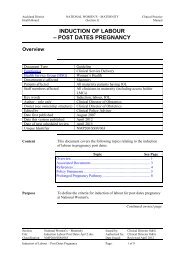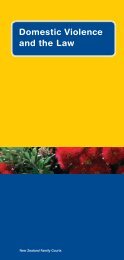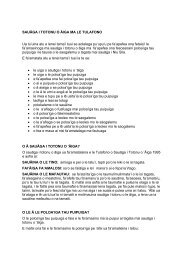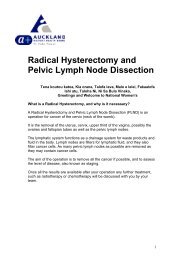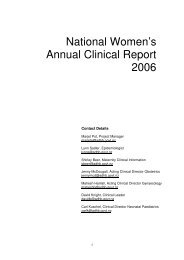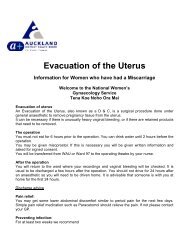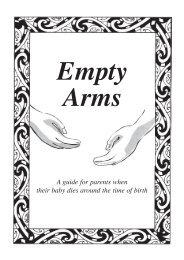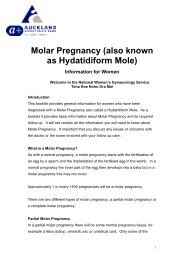National Women's Annual Clinical Report 2010
National Women's Annual Clinical Report 2010
National Women's Annual Clinical Report 2010
Create successful ePaper yourself
Turn your PDF publications into a flip-book with our unique Google optimized e-Paper software.
5.5 Antepartum Haemorrhage<br />
Methods<br />
Antepartum haemorrhage has been defined here to include vaginal bleeding from any<br />
cause at or beyond 20 weeks during pregnancy and labour, and includes placenta praevia<br />
without bleeding. While bleeding before 20 weeks is also important we do not reliably<br />
collect these data.<br />
Data cleaning involved reconciling antenatal summary data and intrapartum complication<br />
data with indications for induction and operative birth. Data were also reconciled with<br />
inpatient coding data.<br />
Findings<br />
Table 30: Antepartum haemorrhage incidence<br />
1995 1996 1997 1998 1999 2000 2005 2006 2007 2008 2009 <strong>2010</strong><br />
Total APH 460 451 453 451 484 594 398 411 533 424 438 438<br />
Incidence % 5.0 4.9 5.6 6.0 6.5 7.6 5.5 5.7 6.9 5.6 5.7 5.7<br />
Proven<br />
101 96 115 82 49 54 41 44 58 36 39 50<br />
abruption<br />
Proven<br />
placenta<br />
praevia<br />
APH (uncertain<br />
origin)<br />
86 67 94 91 74 69 81 68 94 73 66 58<br />
273 287 281 278 361 471 276 299 381 315 333 330<br />
In <strong>2010</strong>, 438 women (5.7% of the total pregnant population) had an antepartum<br />
haemorrhage or placenta praevia without bleeding. This figure has not changed<br />
significantly from year to year and there have been no trends in incidence over time.<br />
In our population placenta praevia is significantly more common with increasing maternal<br />
age: there was an incidence of 0.5% (16 of 3276 women) in women aged 30 or under<br />
rising to 0.9% in women aged >=30 (42 of 4433 women). The incidence of placenta<br />
praevia in women with a previous Caesarean section was 1.3% (16 of 1197 women)<br />
compared to 0.6% (18/2862) among multipara without previous Caesarean consistent<br />
with previous Caesarean section being a risk factor for placenta praevia. The incidence of<br />
the more serious diagnosis of placenta accreta and percreta should be recorded. Many<br />
studies have shown these problems to be associated with previous Caesarean section.<br />
Smoking status, BMI and hypertensive disease were not associated with placenta<br />
praevia.<br />
Table 31: Maternal outcomes of pregnancies complicated by antepartum haemorrhage<br />
Placenta<br />
praevia<br />
n=58<br />
Placental<br />
abruption<br />
n=50<br />
APH<br />
uncertain<br />
origin<br />
n=330<br />
No APH<br />
n=7271<br />
n % n % n % n %<br />
Mode of birth<br />
Normal vaginal 0 0.0 11 22.0 176 53.3 4089 56.2<br />
Operative vaginal 0 0.0 5 10.0 40 12.1 897 12.3<br />
CS elective 37 63.8 2 4.0 39 11.8 1144 15.7<br />
CS emergency 21 36.2 32 64.0 75 22.7 1141 15.7<br />
Maternal transfusion 9 15.5 6 12.0 15 4.5 173 2.4<br />
Women with a placenta praevia had a significant requirement for blood products with 16%<br />
of women requiring transfusion during pregnancy or birth.<br />
60


